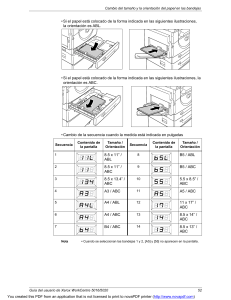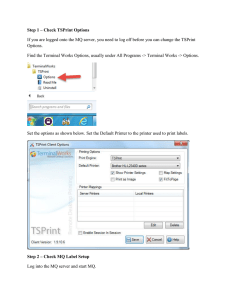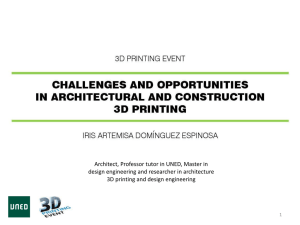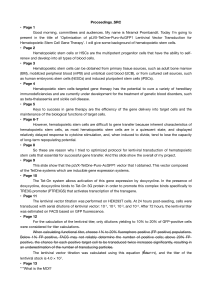seven 3d printing stem projects to do with your class
Anuncio
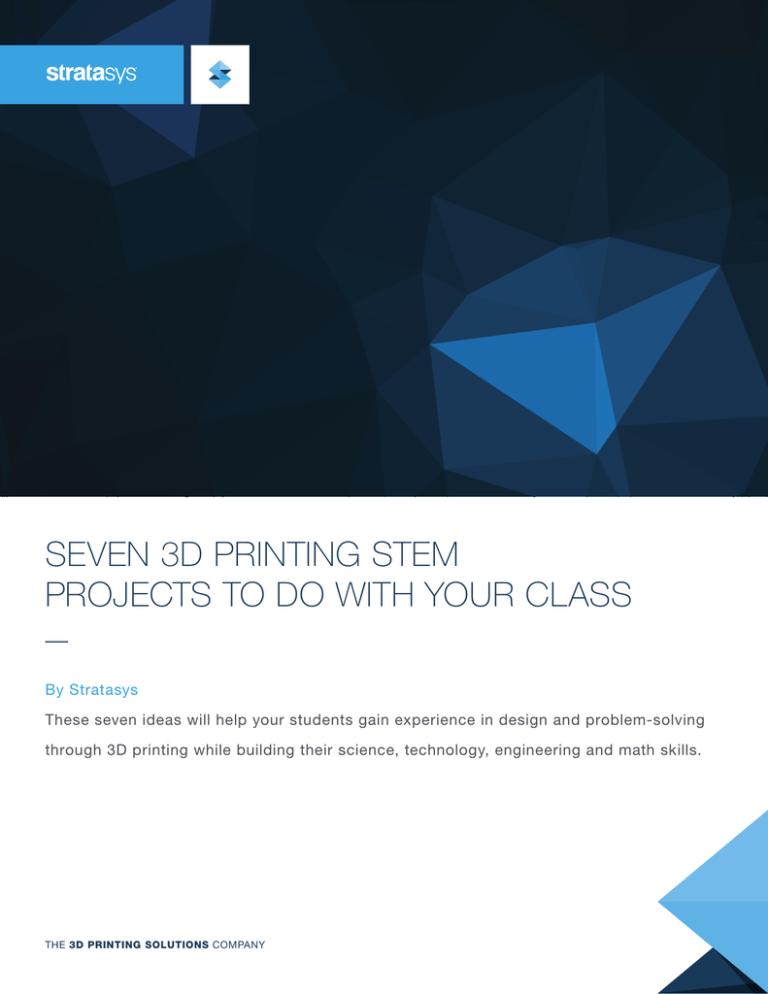
SEVEN 3D PRINTING STEM PROJECTS TO DO WITH YOUR CLASS By Stratasys These seven ideas will help your students gain experience in design and problem-solving through 3D printing while building their science, technology, engineering and math skills. THE 3D PRINTING SOLUTIONS COMPANY SEVEN 3D PRINTING STEM PROJECTS TO DO WITH YOUR CLASS they also learn how to use design and modeling software. Then Jump has them redesign their inventions without the Legos. Previously, Jump would take the designs and spend hours machining the prototypes so the students could see how well their designs worked in real life — even the prototypes he Benilde-St. Margaret’s School added a 3D printer to its curriculum and soon its students were designing and entering robots into international competitions. knew wouldn’t work. By adding a Dimension® 3D Printer to the classroom, students could take responsibility for the production aspects of their INTRODUCTION Teaching students engineering principles isn’t common in American high schools, even though learning by sending their STL files to the machine and watching their designs take form out of ABS plastic. it is the “E” in STEM. Benilde-St. Margaret’s School in Minneapolis is an exception. Instructor Tim Jump runs an advanced competitive science program at the school specifically to teach students problem-solving skills. His approach: to have students take on engineering challenges, break them into component-sized steps, create solutions with their 3D printers, test the solutions and then head back to the drawing board to revamp or refine their designs. “I could talk to a student all day long about the importance of engineering design principles, but until they actually attempt to produce something on their own and encounter challenges and make mistakes, they won’t really be learning,” said Jump. “With the Dimension 3D Printer, students are better able to experiment with their design concepts and test their engineering visions, truly understanding why a part worked or why it didn’t. The printer has really changed the whole learning An early project requires Jump’s students to build dynamic for my students.” a Lego object to hang off a surface and act as a hook to hold something. The process is intended to teach them about mechanical engineering, but As Jump found, 3D printing is a strong draw to encourage students to develop their science, SEVEN 3D PRINTING STEM PROJECTS / 2 SEVEN 3D PRINTING STEM PROJECTS TO DO WITH YOUR CLASS Students in John Keyzer’s technology education classes at Lake Zurich High School in Illinois were given a research project to find out what 14- to 18-year-olds wanted in a game controller. They used the data they collected to design and build prototypes using a Dimension 3D Printer to figure out how well they met their objectives. That encompassed figuring out how parts could fit together to form the controller, how it would Lake Zurich high school students designed game controller shown here in CAD rendering. technology, engineering and math skills — right alongside communication, collaboration and problem solving. Programs that allow students to develop, design and produce solutions give them experience with the activities that will serve them well in college and career. fit in a gamer’s hands, how it would look while a gamer was using it and how well it worked compared to other controllers for helping gamers score points. Keyzer used that activity as a springboard to help those same students take on more ambitious projects, such as building robot parts for his FIRST Robotics team, sponsored by the school’s technology club. “The 3D printer has improved many aspects of our students’ learning Here are seven ideas for 3D printing-based STEM experience,” Keyzer said. projects for helping your students reach their full learning potential. IDEA #2. STUDY THE SCIENCE OF AERODYNAMICS IDEA #1. DESIGN A NEW GAME CONTROLLER The magic of 3D printing is that it allows young people to experience their designs in a way that plain CAD programs don’t allow — especially when the design is for a product intended to be seen and held. The forces of aerodynamics that act on an airplane in flight — lift, gravity, thrust and drag — can be difficult concepts for students to follow through plain lecture or text and images. But if they design and build gliders for themselves, they’ll begin to see how opposing forces balance and act on each other. SEVEN 3D PRINTING STEM PROJECTS / 3 SEVEN 3D PRINTING STEM PROJECTS TO DO WITH YOUR CLASS contains STL files that can be used as templates to help students kick off their computer-aided design efforts. Find this four-minute video (labeled as Episode 3) and other resources at www.stratasys.com/industries/education/ resources. Students can build this glider through an online tutorial from Stratasys. Stratasys® created an online lesson guide available for teachers that will help them walk students through designing gliders and building them with a 3D printer. The curriculum includes leading questions to help students explore the most effective wing designs, determine the correct balance between strength for launching (and crashing the plane) and weight for gaining optimal flight time, and how to design the glider to minimize material waste. IDEA #3. MAKE MANIPULATIVES FOR MATH AND SCIENCE Before young students are able to fully understand math concepts, math manipulatives help them learn about math in a handson method. For decades teachers printed, cut out and taped together paper versions of triangles, squares and trapezoids, until a healthy cottage industry took off in the school supply business for selling the same objects in a more durable form. The lesson also includes design tips for printing glider parts. For example, the minimal wall thickness that can be reliably printed is 0.6 mm. For load-bearing parts, such as the connectors to which the wings are attached, the thickness should be over 2 mm. A four-minute video shows how the basic design of the glider works and walks the student through the use of wing covering material and adhesives to finish off the project. A downloadable zip file Students at the STARBASE non-profit design and test their own rockets using 3D printers. SEVEN 3D PRINTING STEM PROJECTS / 4 SEVEN 3D PRINTING STEM PROJECTS TO DO WITH YOUR CLASS One new approach to meet this material demand would be for students to interview teachers in their own math or science classes or lower grades — acting as a supplier for a school client — to understand what specific needs they might have for manipulatives. Students can then design and print the objects for them. Once the final design and prototype have been approved by the client, he or she may request multiple versions of the A Chico High School student reverse engineers small engine parts and printed physical models on the school’s 3D printer. product in order to allow students in a given class to put the manipulative together from its flat origins and better understand the shape. High School in northern California. Teachers Mike Bruggeman and Tom Phelan reach out to local IDEA #4. ENGINEER WITH A PURPOSE Special education classrooms may appreciate the opportunity to supply their students with stands businesses to invite them to share their design challenges with Chico’s industrial technology students. for tablets, smart phones or other devices. Instead of the district buying gear holders, students can make them with a 3D printer. This is a project where you could encourage your students to talk with potential users to generate ideas for their products, then design and build prototypes. You could even run a competition and have students in those 1:1 classes test and vote on their favorites. The first project — for a company that produces eco-friendly stainless steel water bottles — was to design new canteen lids. The students came up with a mix of options that they produced on the classroom Dimension 3D Printer. The winning prototypes went to China to help the manufacturer there understand what the client wanted produced. It isn’t a giant step from performing work for in-house clients to fulfilling projects from outside organizations. That’s what’s going on at Chico Since then, Bruggeman’s students have worked on cargo and rack products, full-scale models of new structures and designs for sunglasses made SEVEN 3D PRINTING STEM PROJECTS / 5 SEVEN 3D PRINTING STEM PROJECTS TO DO WITH YOUR CLASS from recycled wood. This process gives students NASA provides the materials, equipment, first-hand experience and a deeper understanding mentoring and quality inspection required for about how engineering with a purpose works — the students to fabricate items, and the school is from the initial contact with the client, through expected to provide technical direction and a safe design, prototype and redesign, all the way working environment. through to production of the final product. One school that has participated in this program IDEA #5. TAKE FLIGHT WITH A is Cypress Woods High School, a Texas school NASA PROJECT where students were invited to design and build a Since 2003, NASA has run High Schools United remotely operated vehicle (ROV) that could carry with NASA to Create Hardware (HUNCH), a a camera and maneuver through the International program that works with students in middle Space Station to give earthbound controllers and high schools to make “flight certified” a view of experiments, displays, gauges and productsneeded for space missions. As the switches without the human intervention of the organization explains on its website, “While flight crew. students are building hardware, etc. for NASA, they are also building their interest as researchers, NASA engineers provided the specifications for as well as their self-esteem.” the project, and under the guidance of Industrial Tech Club sponsor and teacher Mike Bennett (formerly with NASA himself), the students broke into teams to work on different systems — propulsion, cameras, control and power. Students drew out initial designs then later developed detailed designs in a CAD system. As they developed their plans, they used 3D printers to build functional prototypes and parts. One version of the ROV submitted to NASA for Cypress Woods High School students test their remotely operated vehicle in a weightless environment. testing included six 3D printed components, SEVEN 3D PRINTING STEM PROJECTS / 6 SEVEN 3D PRINTING STEM PROJECTS TO DO WITH YOUR CLASS including shells and motor covers. The ROV gloves, these boxes allow space crews to is powered by six ducted fans providing two perform experiments. different directions of pitch, roll and yaw motion. The camera transmits audio and video on the 900 “The ability of the Dimension 3D Printer to quickly MHz spectrum. And control is provided via a radio and inexpensively produce parts that are strong control system taken from a model helicopter. enough for use in real applications opens up a world of opportunities for schools such as ours,” The Dimension 3D Printer allows students to said Bennett. continually refine their designs and improve functionality. As an example, one prototype had IDEA #6. CREATE A SOURCE OF the motor fitting only one way into the housing; the HYDRO POWER students updated the design to allow for the motor The Pelton wheel was an ingenious marvel of the to go in from either direction and printed out 19th century that’s still in use today. Although new components. waterwheels existed aplenty before Lester Pelton came up with his unique design, none The Cypress Woods students had the chance was more efficient than his off-center, curved- to test out the ROV in a special Boeing 727 bucket approach, which allowed for the flow or operated by Zero G Corp., which flies parabolic jet of water to turn kinetic energy into rotational arcs to produce periods of weightlessness that last between 20 to 25 seconds. They were able to check out the maneuverability and controllability of their vehicle and its ability to take and transmit images. Based on those tests, the students revised their design for the next generation of ROV. More recently the students built a Microgravity Science Glovebox trainer. With built-in Cypress Woods students test their remotely operated vehicle in a NASA zero-gravity plane. SEVEN 3D PRINTING STEM PROJECTS / 7 SEVEN 3D PRINTING STEM PROJECTS TO DO WITH YOUR CLASS IDEA #7. STUDY HISTORIC TECHNOLOGY If you were doing battle in the Middle Ages, which would have been a more effective long-range weapon — the catapult, which uses tension to fire the projectile, or a trebuchet, which used a counterweight? This STEM lesson uses new technology — 3D printing — to understand historic technology. “Building a Catapult” is an A Pelton wheel energy. A shaft connected to the Pelton wheel can be used to produce mechanical power or run a generator to produce electricity. online guide from Stratasys that provides leading questions, tips and lessons to help your students design and build their own catapults and use those as a starting-off point to explore related topics, such as tension, flexure and torsion. Students can create their own water wheel, either modeled after the original with its 24 spoonshaped buckets, or experiment with their own designs with 3D printing. Students can also The models featured in this lesson are made completely from printed material. There are no springs, rubber bands or bolts used in the experiment with fewer buckets, make variations in placement of the buckets on the wheel’s perimeter and introduce other variables to test out for themselves. STL files for this kind of project are online, or students can go directly to the original images from the Pelton wheel patent to jumpstart their designs. Students can build this catapult through an online tutorial from Stratasys. SEVEN 3D PRINTING STEM PROJECTS / 8 SEVEN 3D PRINTING STEM PROJECTS TO DO WITH YOUR CLASS templates for experimenting with spring arm IDEA, DESIGN, BUILD, TEST, REPEAT designs that have different thicknesses and that Whether you choose one of the projects profiled can be made with different materials. here or guide your students to take on more designs. A collection of STL files provides ambitious projects such as the design and A three-minute video introduces the topic and building of prosthetics, robotics parts, automotive shares some of the different designs students components, movable tools, archaeological may choose to experiment with in this lesson. Find specimens or something else, the use of 3D the “Building a Catapult” online guide and video printing in your classroom can help your learners (Episode 2) at www.stratasys.com/industries/ develop hardcore STEM skills and practice their education/resources. soft skills such as persistence, communication and teamwork. Those are lessons that will last each one of them a lifetime. SEVEN 3D PRINTING STEM PROJECTS / 9 HOW TO MANAGE 3D PRINT PROJECTS FOR OPTIMAL LEARNING students to work in small teams to create highly complex solutions to very simple tasks, such as shining shoes. Teach beyond the physical object. A high school teacher in Ohio has her geometry students create Personalize the learning. If one student decides 3D shapes. As part of that exercise, she also has her iPad stand needs a cupholder and another them capture a screenshot of the 3D shape from wants to add a candy dispenser to a smartphone the software, label dimensions and compute the outlet plate, who are you to say no to volume. Later, she has them post the image and certain genius? their calculations into their online notebooks for review. Perform outside the traditional classroom HOW FDM-BASED 3D PRINTING WORKS first. Before you introduce a 3D printer into the Fused deposition modeling (FDM®) technology classroom for official school work, get comfortable is an additive manufacturing process that builds with the technology by running a school club. The plastic parts layer by layer, using data from CAD students who participate in that will naturally be files. Once the user has imported a design file enthusiastic test pilots and help you work out the and specified options, special software slices lesson speed bumps. the object into ultra-thin layers and generates the instructions for building it. The printer heats Fail early, fail often. Teach students that failure up a ribbon of plastic to make it malleable and is part of the STEM process. A California middle runs it through an extrusion head to produce the school science teacher doesn’t grade results object. When the part is complete, the student can because she believes a complete failure in remove it from the printer, strip away the support a project can make the learning even more material that held the pieces in place and powerful. Promote solutions. A California teacher perform assembly. helps his students learn product development by encouraging them to enter their designs and prototypes into new product competitions. A number of colleges and professional associations host high school events, such as the Rube Goldberg Machine Contest, which encourages SEVEN 3D PRINTING STEM PROJECTS / 10 PUT YOUR PRINTER ON DISPLAY There are few things more enticing to people than watching the amazing process of a design being turned into a physical object. Smart schools put their 3D printers on display as often as possible while building recognizable objects with students standing nearby to explain how they’ve taken a software design and turned it into what the 3D printer is now producing. As instructor Tim Jump from Benilde-St. Margaret’s School explains, “Students are fascinated by the printer. I could sell popcorn and soda and make a fortune ... They’re just mesmerized that this technology is even possible – that we can design a part, hit print and produce it in real life. It’s magic!” That in turn, creates another kind of magic: students interested in pursuing the classes and clubs that will allow them to learn how to use the 3D printer themselves. SEVEN 3D PRINTING STEM PROJECTS / 11 [email protected] ST R ATA SYS .C O M HEADQUARTERS 7665 Commerce Way, Eden Prairie, MN 55344 +1 888 480 3548 (US Toll Free) +1 952 937 3000 (Intl) +1 952 937 0070 (Fax) 2 Holtzman St., Science Park, PO Box 2496 Rehovot 76124, Israel +972 74 745-4000 +972 74 745-5000 (Fax) THE 3D PRINTING SOLUTIONS COMPANY ©2011, 2015 Stratasys Ltd. All rights reserved. Stratasys, Stratasys logo, PolyJet, ABS-M30, ABSplus, Fortus, Finishing Touch, ABS-ESD7, ABS-M30i, ABSi, PC-ISO and FDM Nylon 12 are trademarks or registered trademarks of Stratasys Ltd. and/or its subsidiaries or affiliates and may be registered in certain jurisdictions. Fused Deposition Modeling, FDM Technology are trademarks of Stratasys Inc. ULTEM is a registered trademark of SABIC or affiliates. All other trademarks are the property of their respective owners, and Stratasys assumes no responsibility with regard to the selection, performance, or use of these non-Stratasys products. Product specifications subject to change without notice. Printed in 2014 and in the USA. WP_FDM_7Projects_EN_0115. For more information about Stratasys systems, materials and applications, call 888.480.3548 or visit www.stratasys.com
